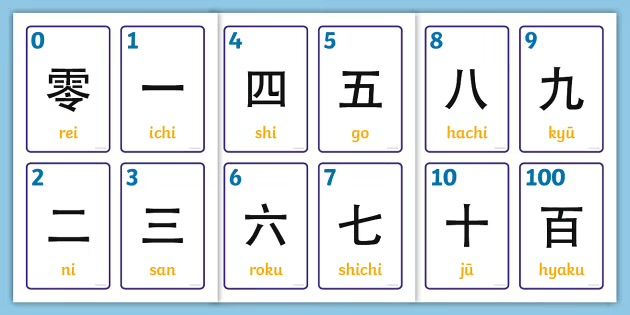Learning how to count in Japanese is an essential skill for anyone delving into the intricacies of the Japanese language and culture. Japanese numbers are not just numerical symbols; they are deeply intertwined with the language's cultural nuances and societal conventions.
In this comprehensive guide, we will explore the Japanese number system, including both native Japanese counting and Sino-Japanese readings.
Whether you're a beginner or an advanced learner, understanding how to count in Japanese will enrich your language-learning journey and provide valuable insights into Japanese culture.

Understanding Japanese Numbers
In the Japanese language, numbers have both native Japanese readings and Sino-Japanese readings.
Native Japanese reading
The native Japanese readings are used for counting items, people, and occurrences. For instance, the number "one" is pronounced as "ひとつ" (hitotsu), "two" as "ふたつ" (futatsu), and so forth.
Sino-Japanese Reading
On the other hand, Sino-Japanese reading is derived from Chinese characters and are commonly used for counting larger quantities, durations, and when expressing mathematical concepts. For example, "one" is pronounced as "いち" (ichi), "two" as "に" (ni), and so on.
Japanese Number System
In the Japanese counting system, numerals alone cannot suffice for counting objects, except for the numbers 1 to 10 in certain cases. This limitation stems from the absence of a conventional singular/plural structure in Japanese.
When counting beyond 10, it becomes necessary to pair Japanese numerals with what are termed as counters.
In this framework, a "counter" serves as a descriptor that specifies the type of object being counted, thereby facilitating the grouping of similar objects.
Counters are classified based on the shape and nature of the object(s) being counted. For instance, the counter used for counting elongated items differs from that used for diminutive objects.
Among the numerous categories, some of the most prevalent counters include "tsu," "hon," "ko," "nin," "dai," and "hiki." Further exploration of these counters will be undertaken later in this discourse.
Numbers can be represented in kanji (Chinese) characters or in numerals. Kanji characters are used for numbers ranging from 1 to 10 individually, whereas combinations of two or more kanji are for numbers exceeding 10.
Counting in Japanese (0 to 10)

Numbers are pronounced in a certain way when you count up from zero* to ten in Japanese. I want you to check how four and seven are read, in particular.
0 - ぜろ (zero)
1 - いち (ichi)
2 - に (ni)
3 - さん (san)
4 - し (shi)
5 - ご (go)
6 - ろく (roku)
7 - しち (shichi)
8 - はち (hachi)
9 - きゅう (kyuu)
10 - じゅう (juu)
Counting Till 100
Counting in Japanese from 10 to 100 involves learning a simple pattern and a few new words. Let's explore how to count in Japanese from 10 to 100.
Starting at 10, we have "juu" (じゅう). To count beyond 10, we simply combine the numbers. For example, 11 is "juuichi" (じゅういち), which literally translates to "ten one." Similarly, 12 is "juuni" (じゅうに), meaning "ten two."
Moving on to 20, we start with "ni" (に), meaning two, and add "juu" (じゅう) to make "nijuu" (にじゅう), which translates to "two tens." Therefore, 20 is "nijuu" (にじゅう).
As we continue, you'll notice the pattern remains consistent. For instance, 21 is "nijuuichi" (にじゅういち), and 22 is "nijuuni" (にじゅうに). We keep this pattern of combining the multiplier (e.g., "ni" for 2) with "juu" (10) until we reach 99.
When we get to 100, we use the word "hyaku" (ひゃく), which means "hundred." So, 100 is simply "hyaku" (ひゃく).
To summarize, counting from 10 to 100 in Japanese involves understanding the basic number words and combining them using a consistent pattern. With practice, you'll quickly become familiar with these numbers and be able to count effortlessly in Japanese.
What Are Japanese Counter Words?
Counters, known as "助数詞" (josuushi) in Japanese, are an integral part of the counting system Japanese people use.
Japanese counters are used to quantify different types of objects, events, or actions. For example, the counter word for flat objects is "枚" (mai), for small animals is "匹" (hiki), and for cylindrical objects is "本" (hon).
Here are a few of the most commonly Japanese words for counters:
- -つ (tsu) : a general-purpose counter only used to count up to nine
- -個 (ko) : usually used for small and/or round objects
- -り / にん (ri/nin) : for counting people
Specific Counters in the Japanese Language
There are hundreds of counter words in Japanese, each serving a specific purpose. Some common counter words include "冊" (satsu) for counting books, "人" (nin) for people, and "台" (dai) for household appliances.
Exceptions and Special Cases
While most counter words follow a specific pattern, there are exceptions and special cases to be aware of. For instance, certain counter words change pronunciation when combined with specific numbers, and there are counter words that have irregular forms.
Practical Tips for Counting in Japanese

Here are also some practical tips on how to use Japanese numerals and count things in Japanese
Learn Common Counter Words
To count effectively in Japanese, familiarize yourself with common Japanese counter words and their usage. Practice using them in sentences to reinforce your understanding.
Pay Attention to Pronunciation
Be mindful of pronunciation when counting in Japanese, especially with native Japanese reading. Practice speaking aloud to improve your fluency and accuracy.
For those who are not acquainted with the Japanese writing system, they may find themselves heavily dependent on the Romanized version (Romaji) to grasp the accurate pronunciation of each number.
Understand Cultural Significance
Counting in Japanese isn't just about numbers; it's also about cultural significance. For example, certain numbers are considered unlucky, such as "四" (shi) for its association with death, while others are considered lucky, such as "七" (shichi) for its auspicious connotations.
Utilize Resources
Take advantage of online resources, textbooks, and language learning apps to enhance your counting skills in Japanese.
Websites and apps dedicated to learning Japanese often provide interactive exercises and quizzes to practice counting in various contexts.
Lingopie offers an immersive platform where learners can delve into the nuances of this fascinating language, including tips on how to start counting quickly in Japanese.
Lucky Numbers and Unlucky Numbers in Japanese Culture
In Japan, the main lucky numbers are seven (七) and eight (八). Interestingly, unlike the number four, the auspiciousness associated with seven and eight does not stem from their pronunciation.
Seven holds significance as a lucky number in Japan largely due to its ties to Buddhism. Furthermore, it is prominently associated with the Seven Gods of Luck (七福神).
While eight is not as widely celebrated, it remains a symbol of good fortune. In Japanese culture, fans symbolize prosperity and abundance, as they expand from a narrow base to a broader end, symbolizing wealth. This concept is known as 末広がり (suehirogari・すえひろがり).
What is the connection to the number eight? Well, upon observing the kanji character for eight, 八 (hachi・はち), its resemblance to the shape of a fan becomes apparent. Consequently, the number eight is regarded as auspicious.
Numbers to Avoid
On the contrary, the number four is considered to bring bad luck in Japan due to its phonetic similarity to the word for death, "shi" (死). Hence, there are two readings for the number four, "shi" and "yon," and people tend to avoid using the former whenever possible.
Similarly, the number nine (九) shares an unfortunate association with the word for suffering, agony, or torture, "ku" (苦). Like the number four, there are two readings for nine – "ku" and "kyu," and individuals often opt for the latter to avoid any negative connotations.
Numerical Superstitions in Everyday Life
Certain buildings, like hospitals, omit the fourth or ninth floors. Maternity wards might skip Room 43 due to its resemblance to "shisan" (死産 – stillbirth).
Specific license plate numbers are avoided, such as 42 (sounds like "shini" – 死に – to death), 49 (sounds like "shiku" – 敷く – to run over), 42-19 (sounds like "shini iku" – 死に行く – to go and die), 42-56 (sounds like "shini-goro" – 死に頃 – time to die), and 24 (can be "nishi" – 二死 – two deaths or two out, for baseball fans).
Some of the Yakuza's more intimidating members opt for license plates like 4444, signifying contempt for mortality. Cars bearing this plate are best avoided on the highway.
With Lingopie, you'll grasp not just the surface meanings, but the cultural significance embedded within each counting method.
FAQs
Below, you will find answers to common questions about how to count in Japanese, and how to learn Japanese numbers more generally.
How do numbers work in Japanese?
In Japanese counting, Arabic numerals or kanji characters are used. Numbers beyond 10 combine these characters.
Counters indicate the type of object being counted, due to the language's singular/plural structure absence. Understanding these fundamentals is essential for navigating Japanese numerical systems effectively, as is practicing the pronunciation based on the Chinese language.
How do you count to 10 in Japanese?
To count to 10 in Japanese, you can say:
- 一 (ichi)
- 二 (ni)
- 三 (san)
- 四 (shi or yon)
- 五 (go)
- 六 (roku)
- 七 (shichi or nana)
- 八 (hachi)
- 九 (kyuu or ku)
- 十 (juu)
How do you say 1 2 3 4 5 in Japanese?
Answer: To say 1, 2, 3, 4, 5 in Japanese, you would use the terms: 一 (ichi), 二 (ni), 三 (san), 四 (shi or yon), 五 (go).
Summing Up: How to Count in Japanese - A Complete Guide
Understanding the intricacies of Japanese counting, including numerals and specific counters, is essential for those seeking to learn Japanese and achieve Japanese fluency.
Embracing this unique system not only enhances language proficiency but also provides insight into the rich cultural heritage embedded within Japanese numerical expression.
Ready to take your Japanese fluency to the next level? Sign up for a 7-day trial with Lingopie today.
Whether you're a beginner or an advanced learner, Lingopie offers tailored resources to suit your needs. Don't miss out on this opportunity to immerse yourself in Japanese language and culture with Lingopie by your side.




![Family Members in Korean [Beginners Guide]](/blog/content/images/2024/04/IMG_3113.png)

![How To Use Mo (も) Particle In Japanese Grammar [Guide]](/blog/content/images/size/w300/2025/06/How-To-Use-Mo-----Particle-In-Japanese-Grammar.jpg)


